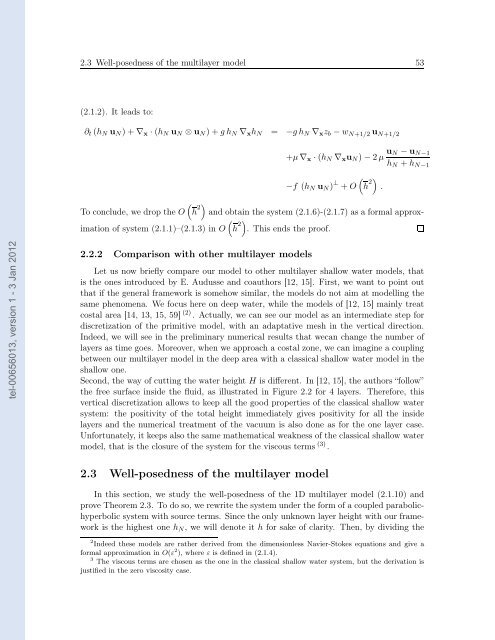Modélisation, analyse mathématique et simulations numériques de ...
Modélisation, analyse mathématique et simulations numériques de ...
Modélisation, analyse mathématique et simulations numériques de ...
You also want an ePaper? Increase the reach of your titles
YUMPU automatically turns print PDFs into web optimized ePapers that Google loves.
tel-00656013, version 1 - 3 Jan 2012<br />
2.3 Well-posedness of the multilayer mo<strong>de</strong>l 53<br />
(2.1.2). It leads to:<br />
∂t(hN uN)+∇x ·(hN uN ⊗uN)+ghN ∇xhN = −ghN ∇xzb −w N+1/2u N+1/2<br />
<br />
To conclu<strong>de</strong>, we drop the O h 2<br />
imation of system (2.1.1)–(2.1.3) in O<br />
+µ∇x ·(hN ∇xuN)−2µ uN −uN−1<br />
hN +hN−1<br />
−f (hN uN) ⊥ <br />
+O h 2<br />
.<br />
and obtain the system (2.1.6)-(2.1.7) as a formal approx-<br />
<br />
h 2<br />
. This ends the proof.<br />
2.2.2 Comparison with other multilayer mo<strong>de</strong>ls<br />
L<strong>et</strong> us now briefly compare our mo<strong>de</strong>l to other multilayer shallow water mo<strong>de</strong>ls, that<br />
is the ones introduced by E. Audusse and coauthors [12, 15]. First, we want to point out<br />
that if the general framework is somehow similar, the mo<strong>de</strong>ls do not aim at mo<strong>de</strong>lling the<br />
same phenomena. We focus here on <strong>de</strong>ep water, while the mo<strong>de</strong>ls of [12, 15] mainly treat<br />
costal area [14, 13, 15, 59] (2) . Actually, we can see our mo<strong>de</strong>l as an intermediate step for<br />
discr<strong>et</strong>ization of the primitive mo<strong>de</strong>l, with an adaptative mesh in the vertical direction.<br />
In<strong>de</strong>ed, we will see in the preliminary numerical results that wecan change the number of<br />
layers as time goes. Moreover, when we approach a costal zone, we can imagine a coupling<br />
b<strong>et</strong>ween our multilayer mo<strong>de</strong>l in the <strong>de</strong>ep area with a classical shallow water mo<strong>de</strong>l in the<br />
shallow one.<br />
Second, the way of cutting the water height H is different. In [12, 15], the authors “follow”<br />
the free surface insi<strong>de</strong> the fluid, as illustrated in Figure 2.2 for 4 layers. Therefore, this<br />
vertical discr<strong>et</strong>ization allows to keep all the good properties of the classical shallow water<br />
system: the positivity of the total height immediately gives positivity for all the insi<strong>de</strong><br />
layers and the numerical treatment of the vacuum is also done as for the one layer case.<br />
Unfortunately, it keeps also the same mathematical weakness of the classical shallow water<br />
mo<strong>de</strong>l, that is the closure of the system for the viscous terms (3) .<br />
2.3 Well-posedness of the multilayer mo<strong>de</strong>l<br />
In this section, we study the well-posedness of the 1D multilayer mo<strong>de</strong>l (2.1.10) and<br />
prove Theorem 2.3. To do so, we rewrite the system un<strong>de</strong>r the form of a coupled parabolichyperbolic<br />
system with source terms. Since the only unknown layer height with our framework<br />
is the highest one hN, we will <strong>de</strong>note it h for sake of clarity. Then, by dividing the<br />
2 In<strong>de</strong>ed these mo<strong>de</strong>ls are rather <strong>de</strong>rived from the dimensionless Navier-Stokes equations and give a<br />
formal approximation in O(ε 2 ), where ε is <strong>de</strong>fined in (2.1.4).<br />
3 The viscous terms are chosen as the one in the classical shallow water system, but the <strong>de</strong>rivation is<br />
justified in the zero viscosity case.

















